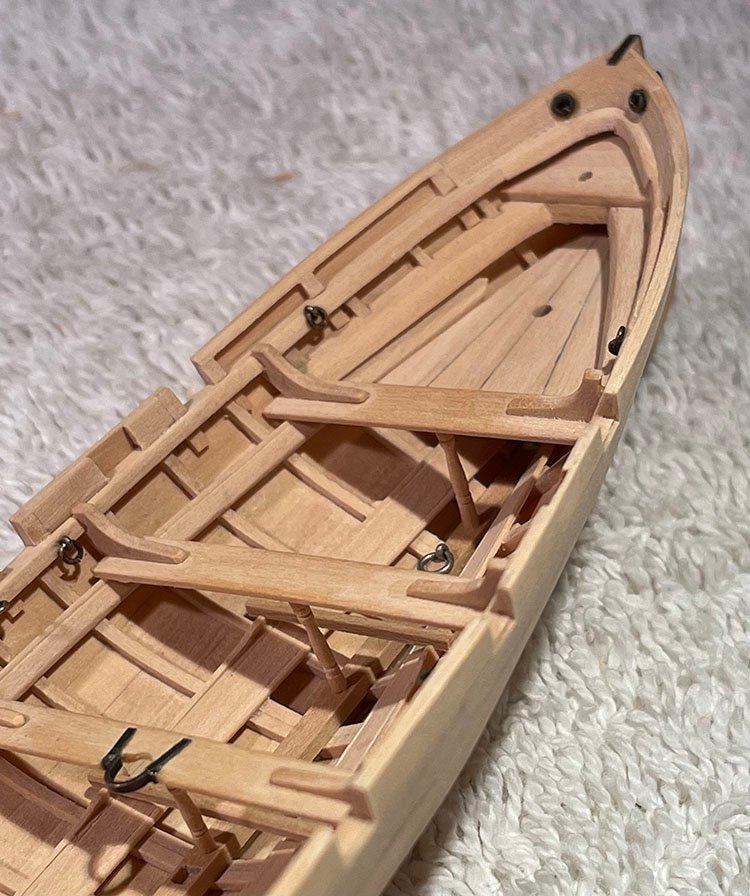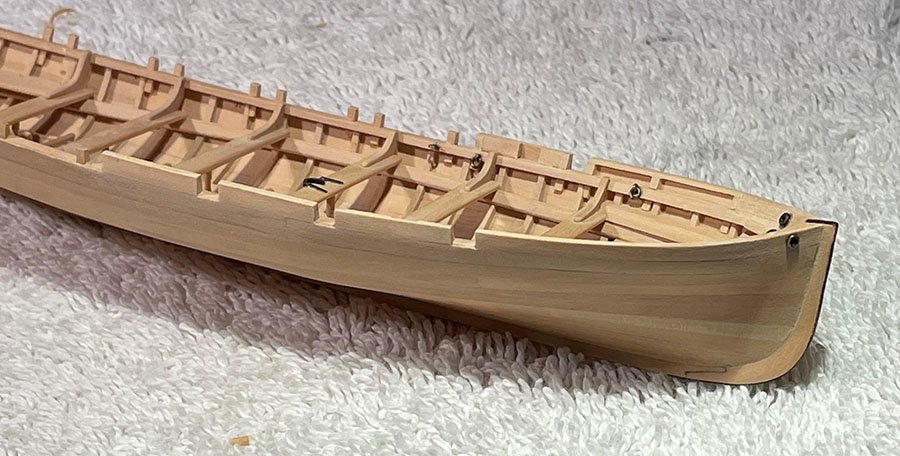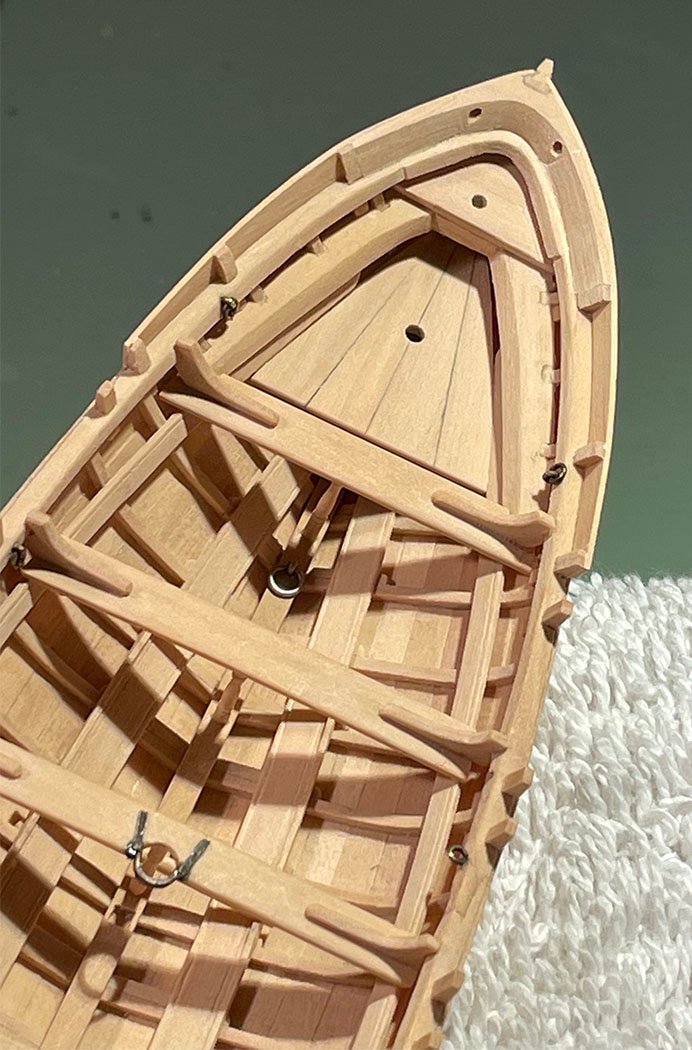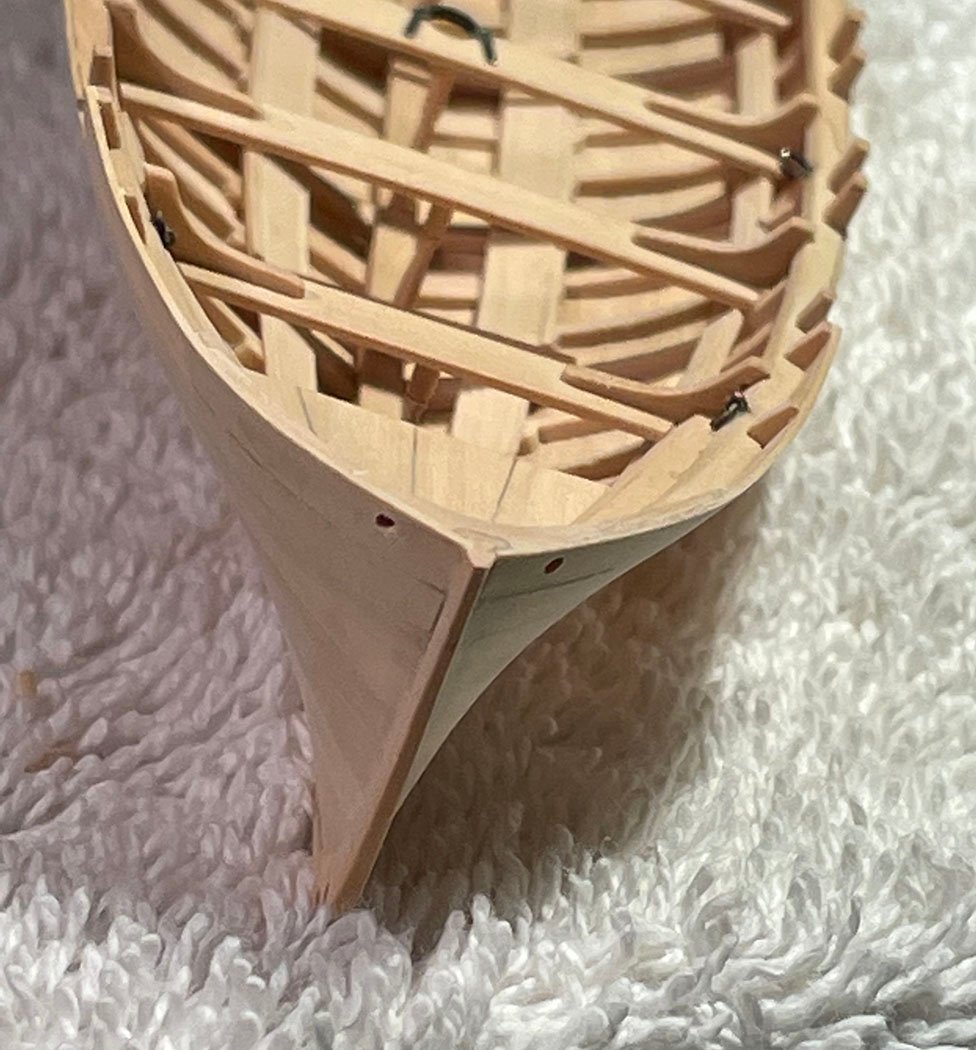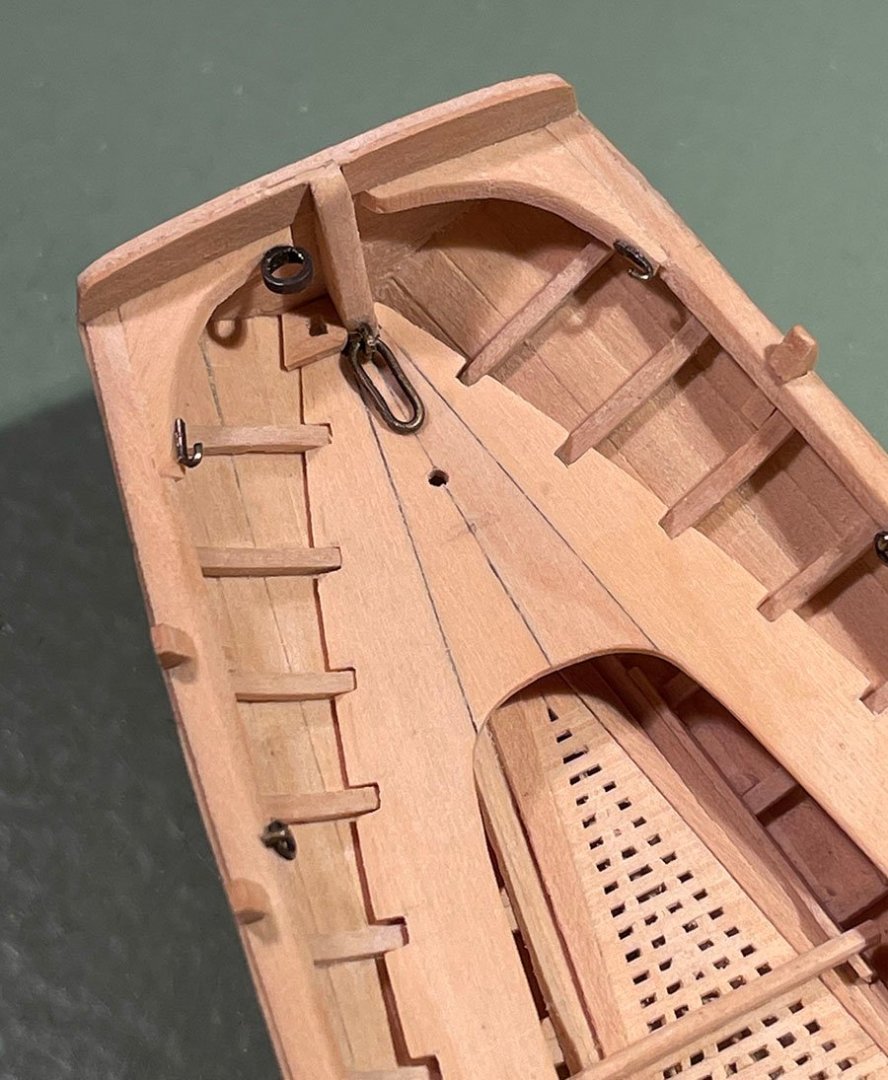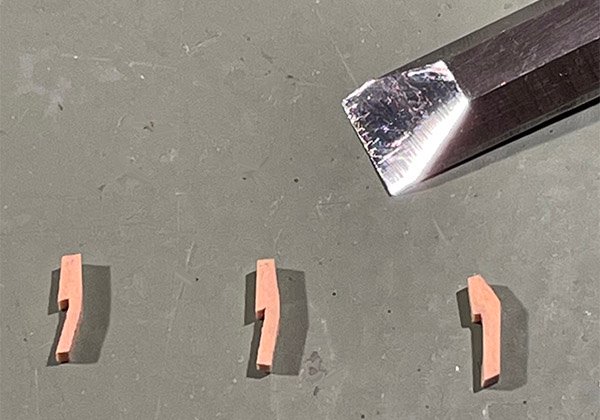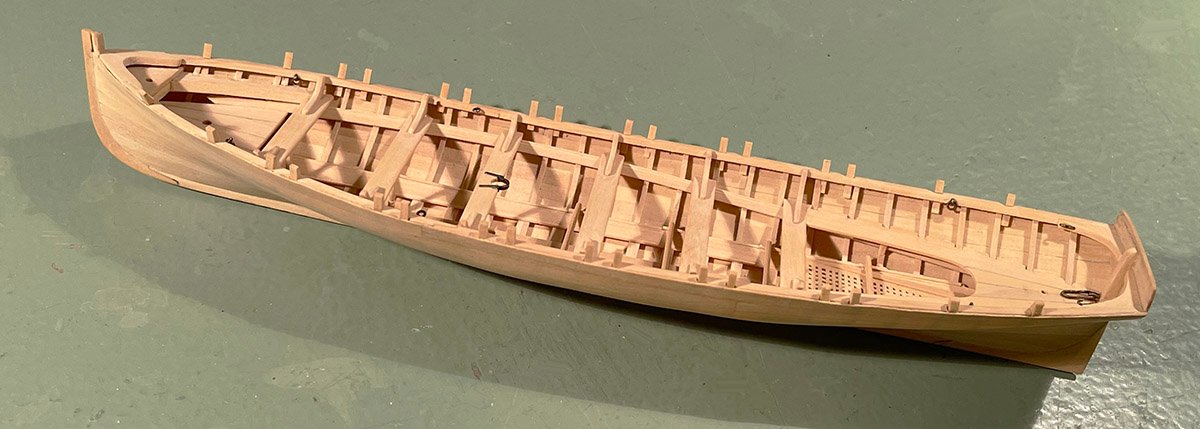-
Posts
13,135 -
Joined
-
Last visited
Content Type
Profiles
Forums
Gallery
Events
Everything posted by druxey
-

Planking options
druxey replied to Don Case's topic in Building, Framing, Planking and plating a ships hull and deck
Yes, you had better plan on paper or risk utter frustration! I might observe that the lowest ceiling planks creep up the bow much too far. The outermost planks should end in the vicinity of the foremost cant frame.That will simplify the congestion up the stemson a bit! -
Moving on, the details at the bow have been completed. I noticed on the photographs of the actual boat that the flanges on the inner sides of the hawse pipes were larger than those on the outer sides. A protective metal strap extends down the face of the stem as well. I'm now working on the wash strakes. First the stub timberheads were sanded to uniform height. Short lengths of plank are being added and then reinforcing pieces of mini in-rail. There are pieces of timber with a gap between tholes 1 and 2 on the prototype. I have no idea what their purpose was, but copied them here.
- 433 replies
-
- open boat
- small boat
-
(and 1 more)
Tagged with:
-

HMS Discovery 1789 by Don Case - 1:48
druxey replied to Don Case's topic in - Build logs for subjects built 1751 - 1800
No, Don, ships of that era had that turn of the clamp aft just as you have it. That is correct, strange as it may look! -
Nice demonstration, dafi. If you are planning on actually manning the capstan in your model, remember that they gripped the bars thumbs upward and palms towards them. (This was to avoid broken forearms should the capstan kick back.) So often the wrong grip is shown, like pushing a baby stroller or bike.
-
Some of you have too little faith in me, others too much!!! Thanks anyway, Toni.
- 433 replies
-
- open boat
- small boat
-
(and 1 more)
Tagged with:
-
Continuing, I made and fitted the bow sections of the wash strake. These were spiled as I had the hull planking, cut and glued in.. The next apart of construction was a nail-biter. The upper bow breast hook and extensions had to be carefully shaped to fit properly, glued in, and then drilled for the hawse holes. I only had one shot at getting the holes in the correct places on either side of the bow. There was virtually no margin for error. Too high, and the drill would break out, too low and the hole would pierce the rub rail that has yet to be installed. Fortunately, all went well. The holes were drilled under size, then slight corrections made with a round escapement file. At this point, the stem was bevelled on each side and the inside bow neatened up.
- 433 replies
-
- open boat
- small boat
-
(and 1 more)
Tagged with:
-
No, the reinforcing piece is on the prototype original, Shipman. It is Plan A, o, ye of little faith!
- 433 replies
-
- open boat
- small boat
-
(and 1 more)
Tagged with:
-
Thank you, Giampiero! I forgot to mention that the transom is now trimmed to its final shape and a reinforcing piece attached to the fore side. Next is the wash strake.
- 433 replies
-
- open boat
- small boat
-
(and 1 more)
Tagged with:
-
More finishing details at the stern; a step and a hoop for an ensign staff. The photo I have of this area shows more metalwork, but it looks as if this was added later by the museum for the anti-hogging arrangement.
- 433 replies
-
- open boat
- small boat
-
(and 1 more)
Tagged with:
-
Exactly, Michael! My party trick is to cut an exact 45 degree angle without a protractor using the reflected image on the back of the chisel.
- 433 replies
-
- open boat
- small boat
-
(and 1 more)
Tagged with:
-
Thank you for looking in and for your kind words. More progress soon!
- 433 replies
-
- open boat
- small boat
-
(and 1 more)
Tagged with:
-
Looks pretty neatly done to this point. There will aways be minor tweaks when building a model.
- 70 replies
-
- Lowell Grand Banks Dory
- Finished
-
(and 1 more)
Tagged with:
-
Use threads instead of battens with a spot of PVA on the frames. To adjust them, wet your finger and roll the thread up or down the frames as required,
-
The many stub toptimbers have been cut and dry fitted. Their shapes vary along the length of the boat. I cut them using my favorite tool; a ¼" chisel. Using a larger blade makes seeing the cutting angles easier. Next will be refining the fit and gluing the toptimbers in.
- 433 replies
-
- open boat
- small boat
-
(and 1 more)
Tagged with:
-
Yes, Shipman, often thwarts were set into scores in the risers. This particular boat did not. I think Eberhard addressed your other points very well. Horst's model is a beauty. Thank you, Eberhard!
- 433 replies
-
- open boat
- small boat
-
(and 1 more)
Tagged with:
About us
Modelshipworld - Advancing Ship Modeling through Research
SSL Secured
Your security is important for us so this Website is SSL-Secured
NRG Mailing Address
Nautical Research Guild
237 South Lincoln Street
Westmont IL, 60559-1917
Model Ship World ® and the MSW logo are Registered Trademarks, and belong to the Nautical Research Guild (United States Patent and Trademark Office: No. 6,929,264 & No. 6,929,274, registered Dec. 20, 2022)
Helpful Links
About the NRG
If you enjoy building ship models that are historically accurate as well as beautiful, then The Nautical Research Guild (NRG) is just right for you.
The Guild is a non-profit educational organization whose mission is to “Advance Ship Modeling Through Research”. We provide support to our members in their efforts to raise the quality of their model ships.
The Nautical Research Guild has published our world-renowned quarterly magazine, The Nautical Research Journal, since 1955. The pages of the Journal are full of articles by accomplished ship modelers who show you how they create those exquisite details on their models, and by maritime historians who show you the correct details to build. The Journal is available in both print and digital editions. Go to the NRG web site (www.thenrg.org) to download a complimentary digital copy of the Journal. The NRG also publishes plan sets, books and compilations of back issues of the Journal and the former Ships in Scale and Model Ship Builder magazines.



